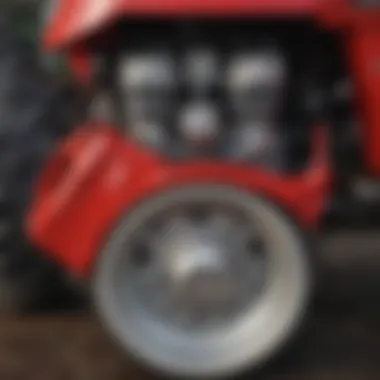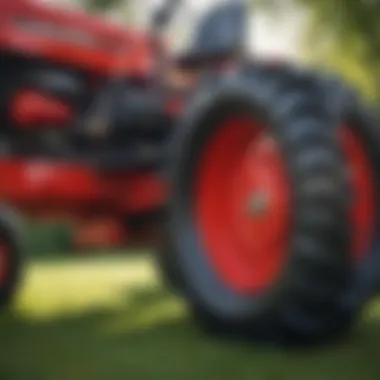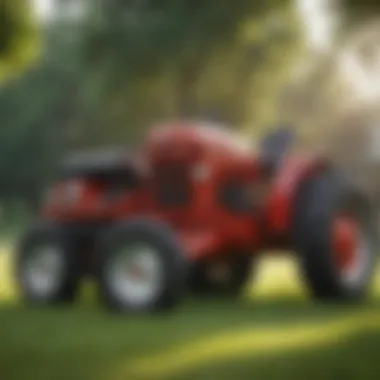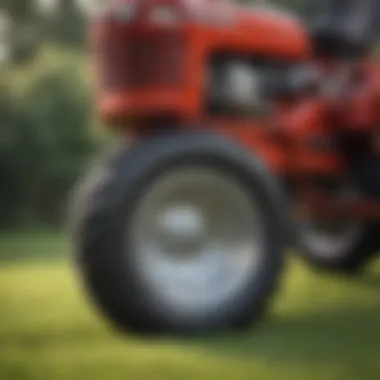Comprehensive Guide to Wheel Horse Lawn Tractor Parts


Intro
This guide aims to provide an in-depth exploration of Wheel Horse lawn tractors. Understanding the key components of these tractors is not just for the sake of knowledge. It is crucial for maintaining their performance over time. Each part plays a vital role in the overall operation of the machine. Moreover, knowing how these components work together can significantly influence the longevity of your equipment.
As more individuals turn to gardening and landscaping, the need for reliable machinery increases. Wheel Horse tractors have gained popularity among both novices and experienced users. This guide will demystify the various parts, enabling easier maintenance, repair, and ultimately enhancing user experience.
Foreword to Wheel Horse Lawn Tractors
Understanding the intricacies of Wheel Horse lawn tractors is crucial for both owners and operators. Wheel Horse has established itself as a reliable and powerful brand in the realm of lawn care and maintenance. Every part of these tractors plays a significant role in their operation, enabling efficient mowing, maintenance, and even snow removal when equipped with the right accessories.
Overview of Wheel Horse Tractors
Wheel Horse tractors are designed for task versatility and durability. They come in different models, each tailored to address various lawn care needs. From residential use to more demanding agricultural tasks, these machines have gained popularity for their robust construction and user-friendly operation. Key features often include ergonomic designs, adjustable seating, and customizable equipment add-ons, which enhance ease of use and comfort during longer operations. The combination of a reliable engine and sturdy chassis makes Wheel Horse tractors a compelling choice for those looking to maintain their properties effectively.
Importance of Understanding Tractor Parts
A comprehensive understanding of tractor parts is vital for maximizing the performance of Wheel Horse machines. Every component, from the engine to the electrical system, works in tandem to ensure optimal functionality. Knowing how each part operates and its maintenance needs can prevent minor issues from escalating into significant problems, thereby extending the life of the tractor. Furthermore, being knowledgeable about parts also informs users when to source replacements or upgrades, allowing for a more economical management of their equipment.
"Maintenance is not just about fixing problems. It’s about preventing them and understanding how your machine works."
This insight transforms owners into informed operators, enhancing their overall experience with their Wheel Horse tractors. Regular inspection of parts, such as the engine, transmission, and drive train, ensures a reliable machine at work. Considering how integral these tractors are to landscaping and farming tasks, comprehending their components is not just beneficial; it is essential.
Key Components of Wheel Horse Lawn Tractors
Understanding the key components of Wheel Horse lawn tractors is essential for proper usage, maintenance, and repair. Each part plays a significant role in the overall performance and longevity of the tractor. Knowing about these components can help users assess issues quickly and carry out appropriate maintenance to keep their tractors in good working condition. From the engine assembly to the electrical system, every section contributes to optimal functionality.
Engine Assembly
The engine assembly is the heartbeat of any tractor. Its performance directly influences the efficiency and effectiveness of the machine.
Types of Engines Used
There are primarily two types of engines used in Wheel Horse lawn tractors: air-cooled and liquid-cooled engines. Air-cooled engines are common due to their simplicity and lower maintenance requirements. They are typically lighter and more compact, making them easier to manage. Liquid-cooled engines provide better temperature regulation and stability during prolonged usage. They often come with more power and are suitable for heavier tasks. Each engine type has its advantages. Air-cooled engines are generally more economical, while liquid-cooled engines offer superior performance.
Engine Maintenance Tips
Regular engine maintenance is crucial for maintaining performance and minimizing repairs. Basic practices include checking oil levels, replacing the oil filter, and inspecting the air filter regularly. Keeping the engine clean from debris will help it run cooler and avoid overheating. Under ideal situations, track the maintenance schedule based on usage hours or seasonal change, as it helps in understanding the condition of the engine over time. Ignoring these steps could lead to significant issues down the line.
Transmission System
The transmission system allows the tractor to change speeds and manage power. Understanding the differences between transmission types is important for making informed decisions about your equipment.
Manual vs. Automatic Transmission
Manual transmission systems provide more control to the operator, allowing for tailored speed adjustments in various conditions. This can be beneficial for users who need precision. Conversely, automatic transmissions simplify the operation, making it user-friendly, especially for those less familiar with machinery. Each type serves user needs differently, with manual systems offering performance and automatic systems offering ease of use.
Common Transmission Issues
Common transmission issues can arise, such as slipping gears, fluid leaks, or engagement problems. These situations require immediate attention, as neglecting them may worsen the condition. Regularly inspecting transmission fluid levels and ensuring connection points are secure can prevent many issues. Keeping an eye on these components aids in identifying problems early and enhances the overall lifespan of the tractor.
Drive Train Components


The drive train is crucial for transmitting power from the engine to the wheels. Its efficiency is vital for performance.
Types of Drive Trains
Wheel Horse tractors primarily utilize two types of drive trains: gear-driven and hydrostatic. Gear-driven systems are known for their durability and reliability. They provide consistent power and are typically easier to maintain. Hydrostatic systems allow for smoother speed control and better maneuverability, making them popular for varied tasks. Selecting the right type depends on intended usage and personal preference regarding operation and maintenance complexity.
Maintenance and Repair
Routine checks of drive train components are necessary to avoid major failures. Regular inspection of belts, pulleys, and fluid levels keeps systems running smoothly. Repairing any damaged components as soon as they are identified will go a long way in maintaining functionality. Keeping the drive train in top shape is crucial for the efficiency of the entire tractor.
Chassis and Frame Parts
The chassis provides structural support for the tractor, making its integrity crucial.
Importance of Frame Integrity
A sturdy frame is vital for the tractor's stability and load-bearing capacity. A damaged frame can lead to severe operational difficulties and safety hazards. Checking for cracks or bends in the chassis can help catch potential problems before they worsen. Maintaining structural integrity ensures that the tractor can handle its intended tasks without compromises.
Repairing Chassis Damage
When chassis damage occurs, prompt repairs are essential. Methods can include welding or reinforcing the structure as necessary. Ignoring chassis issues can lead to more significant problems that complicate repairs and increase costs over time. Understanding how to assess and address damage can extend the life of the tractor significantly.
Electrical System
The electrical system powers essential components, including the starter, lights, and battery, making it an important focus in maintenance.
Battery Maintenance
Regularly checking the battery is important in ensuring that the tractor starts easily. Cleaning terminals and checking connections can help prevent issues. It is also key to keep the battery charged, especially during winter months or extended periods of non-use. Proper battery maintenance leads to fewer starting problems and enhances overall performance.
Common Electrical Issues
Electrical issues can manifest in various ways, such as dim lights or failure to start. These problems generally stem from battery issues, faulty wiring, or blown fuses. Conducting routine checks minimizes these issues and prolongs the life of electrical components. Identifying electrical faults early is critical to avoiding larger, more costly problems later.
Understanding Blades and Mowers
The blades and mowers are crucial components of Wheel Horse lawn tractors which directly influence cutting performance and efficiency. Understanding these elements can aid in better maintenance and operational practices. Proper knowledge about mower types and blade care has long-term benefits, such as improved grass appearance and prolonged mower life.
Types of Mower Decks
Mower decks come in various designs tailored for different tasks. The type you choose can affect not just the quality of the cut but also the versatility of your tractor. For typical Wheel Horse lawn tractors, common deck types include:
- Rotary Decks: Most common in residential use, these decks rotate horizontally to provide a consistent cut.
- Reel Decks: Often used for golf courses, these decks cut grass like scissors, providing a clean look.
- Mulching Decks: Equipped to chop grass into finer pieces, ideal for returning nutrients to the lawn.
- Side Discharge Decks: These decks eject cut grass to the side, useful for achieving quicker cuts but may lead to more mess.
Each type has its specific benefits and is suited for various mowing conditions. Consider what you primarily use your tractor for when selecting the appropriate mower deck.
Blade Sharpening and Maintenance
Regular blade sharpening and maintenance are essential for optimal performance. Sharp blades result in cleaner cuts, reduce stress on the engine, and promote healthier grass. Here are some tips for blade maintenance:
- Inspect Blades Regularly: Check for chips or damage after extensive use.
- Sharpen Blades Promptly: Aim to sharpen blades at least once per mowing season. You can use a sharpening stone or visit a professional.
- Ensure Proper Alignment: Misaligned blades can cause uneven cuts and increased wear.
- Clean Blades After Use: Remove grass clippings and debris to prevent rust and maintain blade integrity.
Maintaining your mower blades can save time and cost by preventing further repairs and enhancing cutting quality.


Proper care of blades is more than just maintenance; it is a critical component of effective lawn care. Following these guidelines will help ensure that your Wheel Horse lawn tractor operates efficiently, providing reliable results in your mowing tasks.
Accessories and Add-ons
Accessories and add-ons play a crucial role in enhancing the functionality of Wheel Horse lawn tractors. Understanding these components not only improves the performance of the tractor but also extends its versatility for various tasks around the farm or garden. Utilizing add-ons can make operations more efficient and decrease the time needed for typical chores. It is essential to select the right attachments to meet specific needs, ensuring the machine is well suited for different tasks.
Snow Removal Attachments
Snow removal attachments, such as snow blowers and plows, are vital for operating a Wheel Horse lawn tractor in winter months. These accessories help facilitate the clearing of snow from driveways and pathways, ensuring safety and accessibility. Here are some critical points to consider when looking into snow removal attachments:
- Types of Attachments: There are different attachments available, such as front-mounted snow blowers and rear-mounted blade plows. Each has its advantages depending on the size of the area to be cleared and the volume of snow.
- Compatibility: Not all snow removal attachments are made for every model of Wheel Horse tractor. It is essential to ensure the attachment matches the specifications of your particular tractor model.
- Performance and Efficiency: Snow blowers generally throw snow farther than manual blades can move it. This performance can significantly save time during heavy snowfall.
- Maintenance: Snow removal attachments require proper upkeep, especially after intense use. Regular checks can prevent rust and mechanical issues, keeping the accessory running smoothly in the long run.
When installed correctly, snow removal attachments can transform your Wheel Horse tractor into an effective winter tool, making it invaluable during chilly conditions.
Cargo and Garden Accessories
Cargo and garden accessories add yet another layer of utility to Wheel Horse lawn tractors. With these attachments, users can transport materials or perform gardening tasks with ease. Here are some details pertaining to common cargo and garden accessories:
- Rear Cargo Racks: These racks can hold tools or supplies, making them ideal for transporting items around the farm or garden. Weight limits should always be observed.
- Dump Carts: Ideal for moving leaves, soil, or other materials. Dump carts can help with the efficient transfer of materials, reducing manual labor.
- Spreaders: Whether for fertilizer or seeds, spreaders attached to Wheel Horse tractors can improve planting efficiency. Proper calibration ensures uniform distribution over the area.
- Tiller Attachments: These are useful for turning over soil and preparing garden beds. They save considerable time compared to manual tilling, enabling more efficient gardening.
Customization with cargo and garden accessories allows tractor owners to optimize their equipment for their specific needs, making tasks less laborious. Overall, choosing appropriate add-ons can significantly enhance both functionality and convenience.
Troubleshooting Common Issues
Troubleshooting common issues in Wheel Horse lawn tractors is a critical skill for any owner. This section covers practical ways to identify and resolve problems that can hinder a tractor's performance. Knowing how to troubleshoot effectively saves time and money. It facilitates ongoing maintenance and prolongs the life of your equipment. Understanding these common issues not only improves operational efficiency but also increases safety during use.
Engine Troubleshooting
Engine problems can arise from various sources. Common symptoms include difficulty starting, unusual noises, or loss of power. To troubleshoot an engine issue, start with the basics. Check the fuel levels and ensure the fuel is fresh. Old fuel can lead to engine failure. Inspect the air filter; if it is dirty, change it. A clean air filter enhances engine performance by ensuring proper airflow.
If the engine cranks but does not start, examine the spark plug. A faulty or worn-out spark plug may require replacement. Ensure electrical connections are secure. Sometimes a loose wire can cause ignition problems.
Regular engine maintenance is crucial. Change the oil at recommended intervals. This prevents sludge build-up, which can lead to engine wear. Also, inspect the belts and hoses for wear and tear. Replacing worn components before they fail can save you from more extensive repairs.
Transmission Problems
Transmission issues can manifest in various ways, such as slipping gears or difficulty shifting. If you notice grinding noises when changing gears, it may indicate low transmission fluid or contamination. Check the fluid level and condition. If the fluid is dark and has a burnt smell, it is time for a change.
For tractors equipped with a manual transmission, ensure that the clutch is working correctly. A malfunctioning clutch can prevent proper gear engagement. In case of an automatic transmission, be on the lookout for fluid leaks under the tractor. Any significant leaks require immediate attention.
Running a tractor with transmission issues can result in more significant problems down the line. Therefore, a proactive approach toward troubleshooting transmission issues is essential. Regularly inspect and maintain the transmission system to ensure longevity and efficient operation.
Electrical Troubles
Electrical problems can often be the most challenging to diagnose. Common signs of electrical issues include a dead battery, non-functioning lights, or equipment not responding. Start by checking the battery. Ensure it is fully charged and connections are free from corrosion.
If the lights are dim or not working, inspect the wiring. Look for frayed wires or loose connections. Faulty wiring is often the culprit behind electrical failures. Additionally, check fuses for any that may be blown, as this is a simple fix that can restore functionality.
For more complex electrical issues, a multimeter may help diagnose specific problems. This tool helps test voltage levels and can pinpoint where failures are occurring. Regular inspection of the electrical system can prevent unexpected breakdowns.
Taking time to troubleshoot enhances not only the performance but also the safety of your Wheel Horse lawn tractor.
Understanding these common problems enables a faster response when issues arise. Being well-versed can also reduce reliance on professional services, empowering owners to tackle problems themselves.


Sourcing Replacement Parts
Sourcing replacement parts for Wheel Horse lawn tractors is a vital aspect of maintenance and repair. Understanding where to find quality components ensures that your tractor operates efficiently and lasts longer. When a part fails, having the right replacement can affect overall performance and reliability. Not all parts are created equal, making the sourcing process an important consideration for any owner.
Replacement parts come in various forms. Choosing the correct type ensures compatibility and longevity. Using substandard parts can lead to more frequent repairs, resulting in greater costs and downtime. Therefore, knowing the types of parts available allows for informed decisions regarding purchases.
A key factor in sourcing parts is identifying whether you should go for Original Equipment Manufacturer (OEM) parts or aftermarket components. Each option has distinct benefits and potential drawbacks, impacting both performance and cost. Evaluating these can help maximize the effectiveness of repairs and maintenance protocols.
Understanding the difference between OEM and aftermarket parts is crucial for making the right choice when sourcing replacement components.
OEM vs Aftermarket Parts
When choosing between OEM and aftermarket parts, one should consider several elements. OEM parts are manufactured by the original company that made the tractor. They are designed to meet the specific standards set by Wheel Horse. Typically, these parts come with a guarantee of quality and compatibility. The benefit of using OEM parts is that they often ensure the original performance of the tractor is maintained. However, they can be more expensive than their aftermarket counterparts.
Aftermarket parts, on the other hand, are produced by third-party manufacturers. These parts often come at a lower price and are sometimes seen as a cost-effective alternative to OEM options. However, buyers should be vigilant about the quality and compatibility of aftermarket parts, as they can vary greatly. On occasion, they might not perform as well or could shorten the lifespan of the tractor.
- Pros of OEM Parts:
- Cons of OEM Parts:
- Pros of Aftermarket Parts:
- Cons of Aftermarket Parts:
- Guaranteed compatibility
- Maintains original performance
- Generally comes with a warranty
- Higher initial costs
- Limited availability of some parts
- Often more affordable
- Wider selection in some categories
- Innovation in design can offer improvements
- Quality can be inconsistent
- Potential for reduced performance
- Warranty often limited or absent
Where to Buy Parts
Acquiring replacement parts for your Wheel Horse lawn tractor can be done through various channels. Each method offers distinct advantages that can enhance your purchasing experience. For those who prefer shopping locally, visiting authorized dealerships or specialized tractor retailers is a solid option. These venues often stock OEM parts and have knowledgeable staff to assist with any queries.
Online purchasing is becoming increasingly popular. Websites like eBay and Amazon offer a wide array of both OEM and aftermarket parts. Always check seller ratings and reviews to ensure credibility. Moreover, several dedicated automotive parts websites specifically cater to lawn tractors, providing a focused inventory.
Here are some reliable sources for sourcing parts:
- Authorized Wheel Horse Dealers – They often have an extensive catalog of OEM parts.
- Online Retailers (e.g., Amazon, eBay) – Good for price comparisons and wider options.
- Specialist Websites – Such as tractorpartsworld.com that focus on lawn equipment.
- Local Repair Shops – Often have parts available or can help source them.
By exploring these options, you ensure that you can find the necessary replacement parts effectively, whether you prioritize quality or cost in your decision.
Closure
The conclusion of this article serves to emphasize the significance of understanding the components and care of Wheel Horse lawn tractors. Knowledge about tractor parts enhances the operational capabilities while ensuring the longevity of the machine. By grasping the intricate details of each element, users can effectively troubleshoot and maintain their equipment, thereby preventing potential malfunctions.
Recap of Key Points
Throughout our exploration, several crucial points were highlighted:
- Components Overview: We discussed essential units such as the engine, transmission, and electrical systems, understanding their roles in tractor operation.
- Maintenance Importance: Regular upkeep is not just beneficial; it is critical for performance and durability.
- Troubleshooting Skills: Recognizing common tractor issues can save time and resources, making repairs more manageable.
- Replacement Parts: Knowledge of OEM versus aftermarket parts ensures users make informed replacements when necessary.
The Importance of Regular Maintenance
Regular maintenance cannot be overstated. It directly affects both the performance and lifespan of the tractor. Simple practices, like checking oil levels or inspecting the blades, can prevent more significant issues down the line.
Some vital maintenance tasks include:
- Engine Checks: Routine oil changes and clean air filters are fundamental for performance.
- Electrical System: Testing the battery and fuses helps in sustaining electrical integrity.
- Drive Train Inspections: Regularly examining belts and chains will ensure smooth operation.
By committing to a regular maintenance schedule, users can avoid prolonged downtimes and costly repairs. A well-maintained Wheel Horse lawn tractor not only performs better but also provides peace of mind for its operator.
"An ounce of prevention is worth a pound of cure." This adage fits perfectly within the context of tractor maintenance. By being proactive, one can ensure that their investment endures the test of time.



